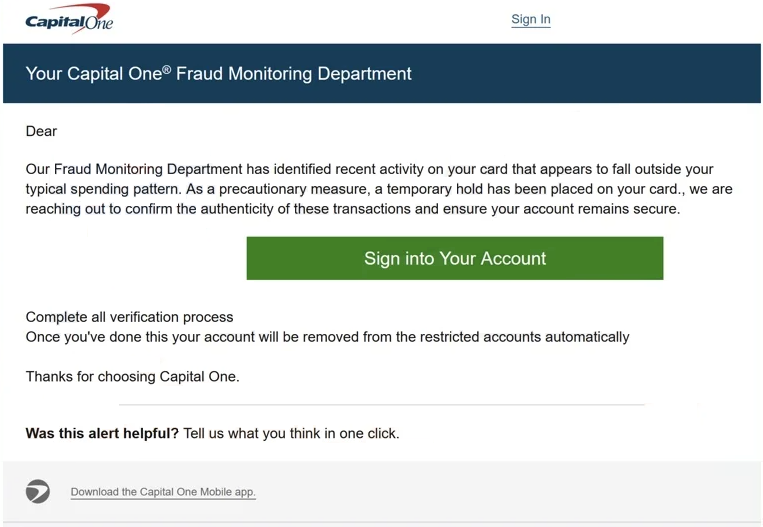Remove “Capital One Fraud Monitoring Department” email
The “Capital One Fraud Monitoring Department” email is part of a phishing campaign that tries to trick users into revealing their Capital One login credentials. The email is disguised as a security alert from Capital One, supposedly informing users about suspicious activity detected in their bank accounts. This has supposedly resulted in a temporary hold being placed on the account holders’ cards. The email asks users to confirm the transactions by signing into their accounts via the provided link. However, if users were to click on the link, they would be taken to a phishing site that asks them to log in to their Capital One accounts. If users were to do that, their login credentials would be stolen. This could allow malicious actors to gain access to users’ accounts.
This phishing email, which falsely claims to be from Capital One’s Fraud Monitoring Department, claims that the bank has identified unusual spending activity on your card, and this has resulted in a precautionary measure being put in place on your card. If you confirm these unusual purchases, the card will supposedly be unblocked. While it lacks specific details, the email pressures you to click on the “Sign into your account” button, which leads to a phishing site that imitates Capital One’s website. The site asks you to log in to your account. If you enter your login credentials on this fake site, they will be compromised, potentially allowing cybercriminals to gain access to your account and make unauthorized transactions.
The full “Capital One Fraud Monitoring Department” email contents are below:
Subject: Unusual Spending Pattern Identified on Your Account
Subject: Important Security Notice: Verify Recent Transactions
Your Capital One Fraud Monitoring Department
Dear -,
Our Fraud Monitoring Department has identified recent activity on your card that appears to fall outside your typical spending pattern. As a precautionary measure, a temporary hold has been placed on your card., we are reaching out to confirm the authenticity of these transactions and ensure your account remains secure.
Sign into Your Account
Complete all verification process
Once you’ve done this your account will be removed from the restricted accounts automaticallyThanks for choosing Capital One.
Login details, particularly for financial accounts, are a major target for cybercriminals. It’s essential for users to be able to recognize phishing emails to protect their accounts from possible theft. If you suspect you’ve fallen victim to a phishing attack, contact Capital One right away to secure your account.
What are the signs of a phishing email?
In many cases, phishing emails are immediately identifiable, as is the case with this “Capital One Fraud Monitoring Department” email. What immediately gives it away is how it addresses you, the recipient. It uses your email username to address you, which is certainly not how your bank would address you. Your bank will always address you by name. Phishing emails also like to use generic words like “Member”, “Customer”, and “User” to address you, which is also an immediate giveaway.
Identifying phishing emails that target many users is usually quite simple because they are not personalized. These emails are often very generic and are typically riddled with grammar and spelling mistakes. In contrast, more advanced phishing attempts are directed at specific high-ranking individuals and tend to look very convincing, making them harder to spot. However, most users will come across the more obvious phishing emails.
When you receive unsolicited emails prompting you to click a link or download an attachment, the first thing to do is verify the sender’s email address. A quick Google search can help determine if the email address corresponds to the actual sender’s identity. Generic phishing attempts often originate from random-looking addresses, while sophisticated attacks may use addresses that closely mimic those of legitimate organizations. This “Capital One Fraud Monitoring Department” email is a clear phishing attempt because it originates from an obviously fake email address that doesn’t include Capital One’s official domain.
Always take a moment to carefully examine any email that urges you to take action, such as clicking a link or opening an attachment. For links, hover over them to check where they lead before you click. If an email suggests there are issues with your account, log in directly through the official website rather than clicking on any links provided in the email. When it comes to attachments, use an anti-virus program or services like VirusTotal to scan them before opening.
Finally, always check the URL of a website before entering any login details. Phishing sites often mimic legitimate ones, but their URLs usually contain clues that reveal their true nature.
Site Disclaimer
WiperSoft.com is not sponsored, affiliated, linked to or owned by malware developers or distributors that are referred to in this article. The article does NOT endorse or promote malicious programs. The intention behind it is to present useful information that will help users to detect and eliminate malware from their computer by using WiperSoft and/or the manual removal guide.
The article should only be used for educational purposes. If you follow the instructions provided in the article, you agree to be bound by this disclaimer. We do not guarantee that the article will aid you in completely removing the malware from your PC. Malicious programs are constantly developing, which is why it is not always easy or possible to clean the computer by using only the manual removal guide.

